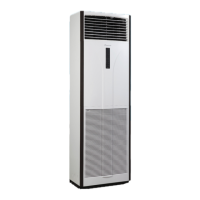Liquid pipe
Gas pipe
Drain hose (Procure in field).
Vinyl Tube (Pipe size 20mm).
Anchor hose here
Bottom Frame
Fan housing
Drain hose inside the unit
Figure H
Air discharge
outlet
Heat
exchanger
Figure I
Drain Piping Work
1. Rig the drain piping.
Rig the drain line to ensure proper drainage. Also, observe the following to prevent leaks.
• Bundle the drain hose to the refrigerant pipes as shown at right or take other means to anchor it
down, so as not to apply pressure to the hose inside the unit. This is necessary to prevent the drain
hose from disconnecting and to ensure proper insulation. Keep the drain hose sloping at a minimum
1/100 gradient, to prevent air pockets.
• Condensate can form on the hose and leak from the unit. Therefore, definitely insulate the hose in at
least the below two places.
• All hose in the room and inside the unit.
• At connection between the unit’s drain hose and building drain pipe.
2. After rigging the drain hose, check that drainage flows smoothly and that water does not
leak from connections.
• Carefully pour approximately 1,000cc of water
through the air discharge outlet so that it falls
directly onto the heat exchanger at an angle
without splashing. (Refer to Figure I).
* If water is poured too fast or it water pressure is
too high, the water will pass through the heat
exchanger and drip on the fan motor below it.
* If water gets on the inner front wall, it will leak onto
the oor.

